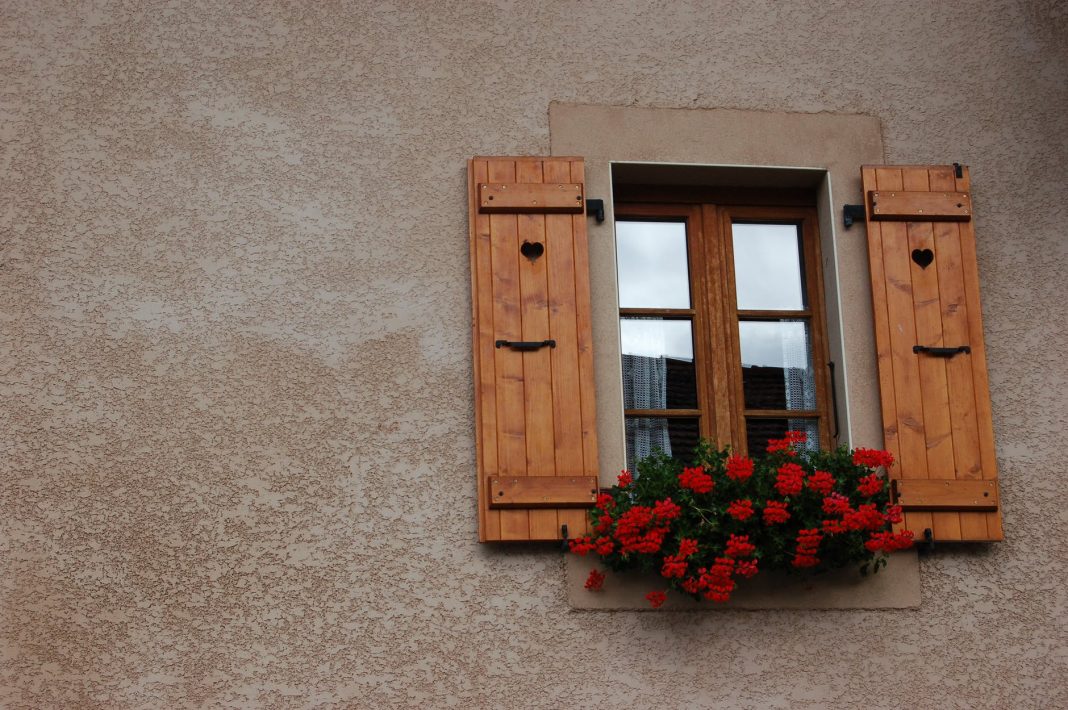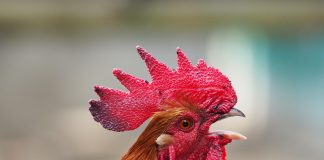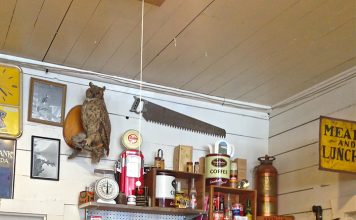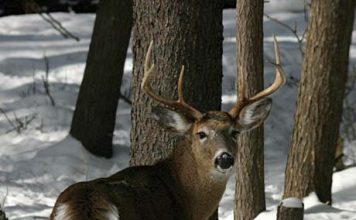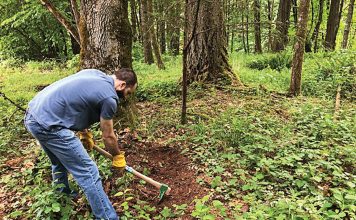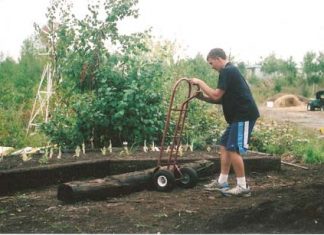| By Anita Evangelista |  |
| Issue #103 • January/February, 2007 |
City gardens and country gardens are differentnot only in the amount of space each can fill, but in the types and quantities of foods that can be produced. Where the country garden can lounge over a half acre, the city garden must fit in tight spaces and nudge around decorative plants and kid’s play areas. The country garden can accommodate low-producing plants that require relatively large plots of land, like corn, but the city garden must achieve the highest productivity from the smallest parcel. This article will help you plan the best city garden you can growand, perhaps, give some new ideas to country gardeners as well.
Planning
Gardening, like everything else we hope will succeed, begins with a plan. I’m going to explain how I planned my city garden and, in the process, help you plan yours. Pencil and paper (or a computer keyboard) are your initial gardening tools. The best time to do this is about January, when you begin to long for springtime, and the gardening catalogs begin to arrive in the mail.
First, take a sheet of paper and divide it into four columns. In the first column on the left, make a list of the fresh foods and herbs you enjoy eatinggo wild with this step, just write down everything you generally buy: Lettuce, sage, tomatoes, zucchini, eggplant, potatoes, kohlrabi, basil, green beans, radishes, and so on.
Next, in the second column, write in how many pounds of the food you eat in a typical week. For example, your family might enjoy a lettuce salad three or four times a weekfigure one pound of lettuce per group meal. Over a typical week, that would add up to about four pounds of the greenery, so put “4#” in this column. This doesn’t have to be exact. A ballpark figure is sufficient. If there are some things you only have once in a while (watermelon? corn on the cob?), skip it in this column.
In the third column, we’ll have you do a little math. Figure that you have a 20-week (five-month) main growing season, more or less, depending on your region. Now, multiply the “per week” amount times 20 weeks and find your “seasonal consumption” rate of the food; write that in column three. For lettuce, that four pounds per week becomes 80 pounds (4 x 20 = 80) over the growing seasona respectable amount of greens. For occasional items, such as watermelon, just put the number consumed per season in this column (that is, “3 watermelons” or “12 ears of corn”). Ballpark-figure this column, too, just to give you an idea of your regular consumption patterns.
If you wish, you can continue into the fourth column. Here, you can ballpark the cost of the goodsthose weekly four pounds of lettuce, if they come precut in a bag, probably run you about $2 per pound or more, meaning you spend more than $160 per season just on salads (4# x $2 x 20 weeks). A single watermelon or pumpkin might be $7, but if you buy one only in the summer, it might not set you back enough to be worth going through the effort to grow it.
|
At this point, you should have a pretty good idea of what foods are mainstays in your diet and which are the infrequent treats. Go ahead and cross off the food items that you consume just a few times during the season. Those foods can still be purchased when you want them. Here’s what I’ve got on my family’s list of regulars: Basil, cilantro, lettuce, green beans, potatoes, tomatoes, sweet potatoes, cucumbers, beets, turnips, strawberries, blackberries, dill, green peppers, jalapeno peppers, green onions, garlic, zucchini. After looking at the list, I put a question mark next to the cilantro because our local market always has it fresh now, and it’s very inexpensive.
Selecting
From my list, I started to examine the “relative value” of the items I had room for in my small available garden area. Tomatoes, for example, are a backyard garden favorite, and there are varieties for every taste. It requires about 3 pounds to fill a quart jar, and a quart makes about a single family meal for us. Canning requires several hours of uninterrupted time. A single plant might produce between 3 and 15 pounds over a season, roughly 6 to 25 tomatoes, averaging around 7 tomatoes per plant. Each plant requires about 2 square feet of space, a considerable garden area in an urban backyard, so there isn’t likely to be enough production from three or four plants to provide fresh eating and sufficient extras to make canning or preserving cost-effective.
It’s cheaper, and a better use of my time, to grow highly productive cherry tomatoes and purchase canned tomatoes in case lots from discount chains. Bite-sized cherry tomatoes produce all season, crank out dozens and dozens of fruit, come in several varieties and colors, and can be easily dried for later use if there are extras. So, this year, I planted three cherry tomatoes in pots and let them go wildand they did! At the current price for small boxes of cherry tomatoes, I figure we saved more than $100 on this one item alone. Plus, I collected seeds from the open-pollinated plants and won’t have any seed expense next year, either.
Green beans are another productive plant that can be harvested for a long period through the season. Our favorites are the Italian varieties, the flat, wide, flavorful beans that are eaten fresh and come in green, purple, and yellow types. For the urban garden with limited ground, pole beans are more generally productive over a longer period than bush beans. They can be trained up on any kind of supportchain link fence line, trellis, arbor, or even among flowering plants. The traditional bean-pole teepee can provide a play area for the kiddies while training the plants as well. Italian pole beans will keep climbing and producing throughout the season, and they do well in hot weather. Shorter bush beans are easier to harvest, but their production is short term and limited.
Zucchini and other squash are available as bush plants and as the regular vine types. Bush plants do require less ground space, and were developed for city gardeners, but my experience with bush plants has been disappointing so far. The production just isn’t there over the season. The vine varieties, though, can be planted so the runners grow in among other plants; finding a hidden cache of squash or cantaloupe among the roses is always a pleasant surprise. I’m planning to experiment with bush patty pan squash next year, putting three to four seeds in a single larger planter, then culling down to two or three of the biggest seedlings. If the plants look like they are going to slow production, I’ll probably transplant some basil starts into the pots to replace the squash.
Herbs and spice plants can fit just about anywhere in the garden space. We are fanatical about basil and would consume fragrant basil pesto almost every meal if we could, but even with around 30 plants this last year, I didn’t have quite enough. Considering that our local markets carry single stems of basil for about $1.50 each, we’ve probably saved on the order of $300 by planting our own. Next year, I will be planting it heavily around small fruit trees, among flowers, and in various pots as well. Genovese (large leaf) basil is quite attractive as a small row or mini-hedge, too.
Onions are wonderful for seasoning meats, veggies, and salads, but there’s no culinary law that requires chopped bulb onions. Green bunching onions look like an ornamental spiky grass clump. Later in the season, purple flower heads develop and eventually provide seeds for next year. In the meantime, it’s possible to harvest thick handfuls of long narrow “chives” every few days. The flavor is bright and the stems are crunchy. Several of these onion clumps generally take care of our seasonal flavoring needs, plus provide plenty to dry for winter soups and stews. On those days when someone needs a large slab of onion on a burger, there’s always the supermarket. Alternatively, a few onion sets (baby bulb onions) can be tucked into the landscaping for visual interest when the tall stems develop. If interplanted with other ornamentals or beside tomatoes, for example, you can expect to harvest about four ounces of bulb onion for every starter set planted.
Turnips are a good fall-planted crop, especially in the city garden. After the garden areas have been harvested, turn and refeed the soil, scatter turnip seeds, and rake lightly to cover. Just about the time you are bagging up the last of the autumn leaves (and mulching them), the turnips will be showing their greens and turning into delicate golf-ball-sized treats that can be used in any potato recipe. Even a 6-foot square urban garden can easily yield upwards of 25 pounds or more of turnips, especially if left to grow until covered by a light dusting of snow; cold sweetens the flavor. Turnip greens can be harvested lightly without setting back the plants significantly.
One food item that doesn’t make much sense in a backyard city garden, unfortunately, is corn. Each individual plant requires a relatively large footprint in the garden, minimum of 18 square inches, and in order to assure pollination, at least six rows by six rows is needed (36 plants). And, each plant typically produces only one to three ears. That could take up to 9 square feet of space for about 30-60 ears of corn. If your family is like mine, that’s about two barbeques’ worth. That’s roughly 15 pints, a little more than a case of canned corn, worth about $7 in the supermarkethardly a good use of very limited space. Of course, if you’ve got the ground and inclination, just remember the minimum of 6 rows by 6 rows to ensure pollination, unless you plan to pollinate by hand.
Preparing
One of the issues facing a city gardener is the best method of acquiring plants: Is it better to go with started plants or to set seeds? Each method has its benefits and drawbacks. Started plants are easy easy easyyou just buy it and pop it into the ground. Additionally, started plants are usually available early in the season, so you can get a jump on the harvest. The main drawback is that a single healthy starter can cost three or four times more than a packet of seeds, and only gives you one plant. If you plan to garden in a big way in your small space, you could spend almost as much on starters as your projected harvest will be worth, which tends to negate the cost benefit of home gardening.
On the other hand, if you start with seeds planted directly in the ground, your harvest will be later in the season, but your costs will be much lower. Some gardeners believe that plants that aren’t disturbed while growing are healthier and hardier, too. If you save your own seeds, even on just a few plants, you’ll save additional cash. Seed packet labels advise the proper planting time for your region. Some seeds can be started indoors in styrofoam cups and potting soil under a south window or grow-light, which can provide the benefit of both started plants and low-cost seeds.
Feeding
Keeping a city garden growing well helps it produce well. Plants wilted by heat or that aren’t watered sufficiently during dry spells, or those that don’t get properly fed, simply won’t give you the bounty that you could have. Plants in pots are particularly susceptible to weather changes and rely on your generosity with the water and fertilizer to keep them going. Plan to hand water your garden if it doesn’t rain for a week or if the soil around the plant is dry as deeply as you can stick your finger into the soil. Then, deep soak it rather than just sprinkling the surface.
If you have not planted organically in the past, I strongly suggest that you not make organics a priority, because it’s not as easy as it looks. Spend a few seasons getting used to growing plants using commercial pellet vegetable fertilizers, monitoring insect activity and the diseases your plants experience. If you decide to go organic, check local gardening shops; most now support organics with safe fertilizers for food plants.
Planting
Now that you have a fair idea of what and how much you would like to grow in your city garden, the next step is finding spots to grow it in. Think small scattered plots. Think up. Think containers. Between these three essentials, you can grow just about anything in an extremely limited amount of space.
|
Small scattered plots fit in nicely with an urban landscape, planning various items within an existing landscape scheme. Look for corners, edges, backgrounds, and open spots in the yard layout. Ideally, if you draw a map of your planting areas and layout the location of existing flora, you’ll have a clearer idea of spots that can be converted to food plants. Keep in mind that if you are planting food near conventional landscaping, you may need to alter fertilizing and pesticide spraying to more food-friendly alternatives.
“Edible landscaping” has been a gardening theme for the past several decades. Plant colorful kale along walkways, scented herbs in clumps below flower displays, and beans to twine up over existing trellises or low walls. Strawberries make beautiful decorative plants as well as producing fruit throughout the season (if you choose long-bearing varieties). Recently, landscapers have discovered that the many varieties of sweet potatoes, with their colorful heart-shaped leaves, make beautiful display plants. Berry bushes can be planted behind tall flower displays or along a fence line to soften the appearance and give a “wild” quality to the area.
Smaller plants, such as green onions, garlic, dill, and other herbs, fit nicely beside many other types of plants, and may help deter pests. Every tomato plant can be paired with garlic and basil since each helps the other grow better. If you like garlic, tuck a clove or two in every open 2×2-inch spot. You’ll have more than you know what to do with at the end of the season.
If you have a patch of lawn that you’re willing to give over to a garden, here’s an easy way to prepare the soil. In early spring (or, preferably, the fall before you plan to garden), lay out the area of your garden-to-be and place several layers of newspaper and/or plain un-coated cardboard over it. Put a thick layer of mulch or leaves over that. Weight it down with rocks or border the area with recycled wood. Now, just wait. By late spring, all the turf will have died back, and the newspaper or cardboard will be well on its way to dissolving. Earthworms may have moved in, too. This all provides a nice layer of compost under the top mulch layer. Don’t uncover this area. When you are ready to plant, just dig a hole through to the dirt and put your seeds or started plants directly into the ground. As long as you don’t disturb the underlying soil, you’re less likely to have to battle weeds as well.
Grow some plants “up.” In a conventional rural garden, plants can be left to splay over hill and dale, covering vastly more ground than actually required to put down strong roots. In an urban setting, training plants to trellises and even weaving them into chain link fences can be an excellent way to convert air space into garden space. I’ve grown beans in long, narrow, deep window-box type planters and run strings up over windows on the south side of the house. The beans love the heat and extra reflected light from the windows, provide shade as they grow, and can be easily harvested by moving the screen and picking directly through the window. A 16-foot long wire hog panel will bend in an attractive arch to provide
a makeshift trellis and is strong enough to hold cucumbers, cantaloupes, and even grape vines, and has conveniently sized openings to pick through. Heavier fruit and squash can be slipped into the leg cut from old pantyhose and tied to the trellis structure. As fruit enlarges, the hose stretches to accommodate and may save it from an early drop. Cucumbers grown on trellises are straight and don’t get exposed to ground organisms that might cause mildew. Be sure to mulch heavily around the roots of trained plants to preserve moisture.
Containers can grow an abundance of food. A container is anything you can fill with dirt that will provide sufficient drainage so roots don’t get waterlogged. Aside from the usual and obvious (and expensive) decorative planters at home stores, don’t ignore the benefits of coffee cans, plastic carriers, old bathtubs, laundry baskets, and even trash barrels. Containers can be free-standing or placed into a hole dug in a decorative spot. This year, we took around four pounds of sprouted and spindly potatoes leftover in a forgotten bag and planted them in a 35-gallon plastic trash can. We cut a set of drainage holes in the container, then dropped about a foot of dirt in the bottom and set the spuds down into that. They were eager to grow. After each 6 or 8 inches of new tops, we’d bury everything but the top inch in more soft dirt, although we could have used any low-nitrogen cover, including shredded newspapers. The plants eventually reached the top of the barrel, and were completely covered in dirt. By the end of the season, we tipped the barrel, and recovered about 60 pounds of potatoesgiant spuds near the bottom and fresh “new” potatoes near the top.
Next year, we think we may be able to provide our total winter potato requirements in four or five barrels like this one. We’ll have to build some storage areas into the cool basement to accommodate that many potatoes, though.
Finally….fingerblight!
One of the greatest pest menaces faced by a city garden is fingerblight, the tendency for just-ripe goodies to disappear from the landscape. Passersby may find your sidewalk border of tomatoes and seedless blackberries too tempting to pass up, and the harvest can be decimated just as badly as if locusts move in. The key to protection against fingerblight is simple: Don’t advertise and don’t plant obvious foods in public view. If times get rough, it might even be wise to discretely screen backyard garden areas as well. Interestingly, we’ve got both a mini nectarine tree and a dwarf peach in our tiny front landscape, trees heavily loaded with fruit, but we’ve never had a single fruit go missing.
With a bit of hard work and thoughtful planning, it is possible to provide home-grown goodness in a small amount of space.


